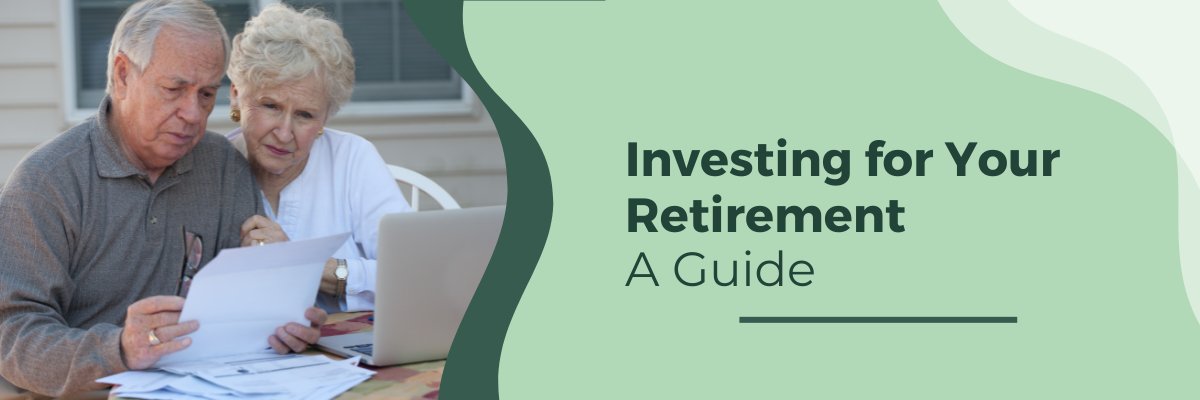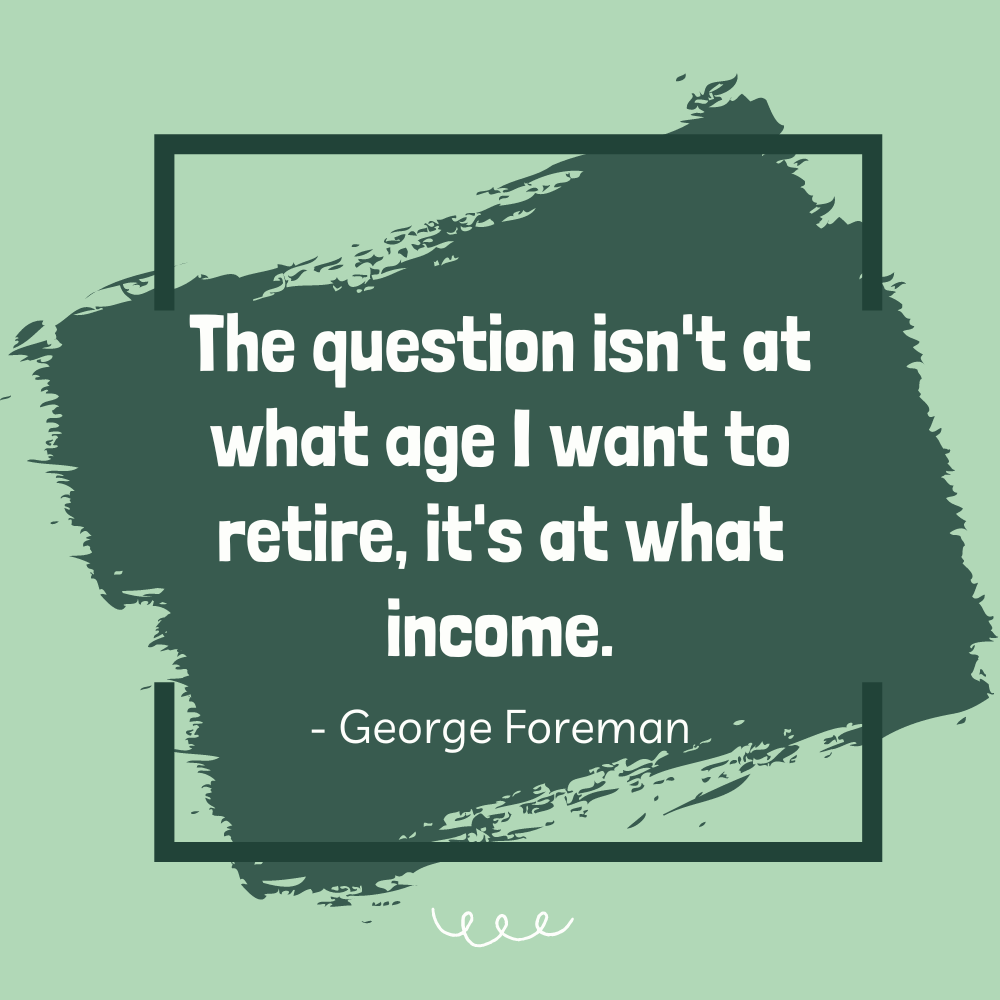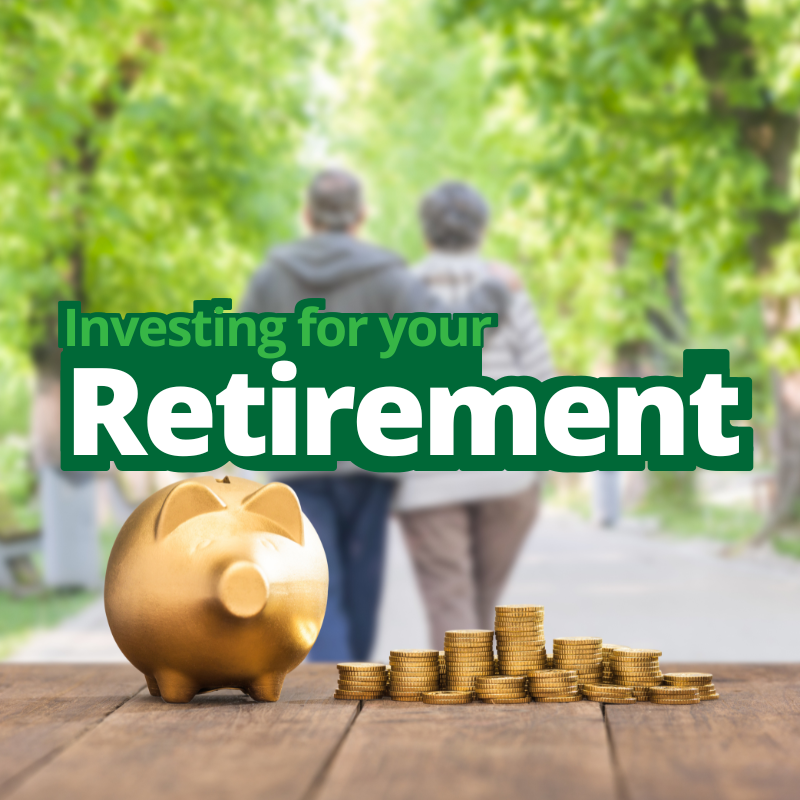No products in the cart.
Family And Children, Financial, Working class
Investing for your Retirement: A Guide

Why Should You Consider Investing In Your Retirement
At what age you want to retire is not the question. It is what income do you want to retire at? The process of planning for retirement involves many steps and changes over time. You must create the financial cushion that will cover everything if you want to retire in luxury, security, and with plenty of fun. The fun aspect makes sense to focus on the important—and maybe boring—portion of making travel arrangements.
Thinking about your retirement objectives and how long you have to achieve them is the first step in retirement planning. Then you should consider the several retirement account types that can assist you in raising funds necessary to finance your future. You must invest the money you save for it to grow.
The final aspect of preparing is taxes: If you’ve accumulated tax deductions for the money you’ve put into your retirement accounts over the years, you’ll face a significant tax charge when you start taking those funds out. While you are saving for the future, there are strategies to reduce the retirement tax hit—and ways to carry on the process once the day comes when you stop working.
Mins to Read: 14 minutes
Age: 21 – 41 years old

Factors to Consider
Consider some elements that will impact your retirement goals when thinking about retiring. What, for instance, are your family’s plans? Starting a family is a significant life ambition for many individuals, but raising children can severely deplete your savings. The kind of family you want will affect how you plan for retirement.
Likewise, it is essential to consider your retirement plans, including any modifications to your house or place of living. Traveling extensively will consume your retirement savings more quickly than staying at home, even though it can be an exhilarating journey. On the other hand, relocating to a nation with a meager cost of living can enable you to stretch your savings while still enjoying a high level of living.
While pension funds were previously the standard for skilled workers, self-funded plans have essentially taken their place. Your retirement approach will depend on the tax-advantaged accounts you have access to because these have a maximum contribution cap.
Following careful consideration of these elements, take the following actions to prepare for your retirement:
1. Understand Your Time Horizon
Your current age and anticipated retirement age lay the foundation for a successful retirement strategy. The higher the level of risk that your portfolio can handle, the longer you have till retirement. Most of your assets can be in riskier investments, such as equities, if you’re young and have more than 30 years till retirement. Although there will be some volatility, historically, equities have outperformed other products, such as bonds, over lengthy periods. The operative word here is “long,” which denotes at least ten years.
To keep your purchasing power in retirement, you also need returns that surpass inflation. Since inflation devalues your money, it’s like “compound anti-growth.” Over 24 years, a relatively little inflation rate of 3% will reduce the value of your investment by 50%. Each year may not seem like much, but it has had a significant influence over many years.
In general, your portfolio should be more concentrated on income and capital preservation as you get older. This entails placing a more significant portion of your portfolio in safer investments, such as bonds, which won’t offer you the returns of stocks but will be less volatile and give you income that you can use to support yourself. Additionally, you won’t be as concerned about inflation. A 64-year-old who intends to retire the following year does not worry as much about an increase in living expenses as a much younger professional who has just started their career.
Your retirement strategy should be divided up into various parts. Assume a parent wants to retire in two years, send a child to college when 18, and relocate to Manila. The investing strategy would be divided into three time periods from the standpoint of creating a retirement plan: the two years leading up to retirement (contributions are still made to the plan), saving for and paying for education, and residing in Manila (regular withdrawals to cover living expenses).
To choose the best allocation method, a multistage retirement plan must consider different time horizons and related liquidity requirements. Additionally, when your time horizon shifts over time, you ought to be rebalancing your portfolio.
2. Identify Your Retirement Spending Commitments
You can determine the necessary amount of a retirement portfolio by having reasonable expectations about your post-retirement spending patterns. Most respondents think their annual spending will only be between 70% and 80% of what it was before retirement.
Such an assumption is frequently unfounded, mainly if the mortgage is still owed or if unanticipated medical costs arise. Retired adults sometimes blow their first year’s savings on vacation or other wish-list items.
Every year, living expenses rise, particularly healthcare costs. As people live longer, they want to enjoy their retirement. Adults in retirement will need to save and invest more money because they will need more income for extended periods.
Retired individuals have more time for travel, sightseeing, shopping, and other pricey hobbies because they are, by definition, not working eight or more hours each day. Since higher spending in the future necessitates more significant savings now, setting precise retirement spending targets aids in the planning process.
Your withdrawal rate is one of, if not the biggest, determinant of how long your retirement portfolio will last. The amount of money you withdraw annually and how you invest your account will depend on how well you predict your retirement expenses.
You can quickly outlive your portfolio if you understate your expenses, and if you exaggerate them, you run the risk of not being able to enjoy the kind of retirement you want. When making retirement plans, it’s essential to consider your longevity to avoid outliving your savings.
3. Compute the After-Tax Return on Investments
The after-tax real rate of return must be computed to determine whether it is feasible for the portfolio to generate the required income once the predicted time horizons and spending requirements have been established. Even for long-term investing, a needed rate of return of more than 10% (before taxes) is typically unattainable. Because low-risk retirement portfolios are primarily made up of low-yielding fixed-income securities, this return criterion decreases as you age.
Assuming no taxes and the preservation of the portfolio balance, if a person, for instance, has a retirement portfolio worth Php 400,000 and income needs of Php 50,000, they are relying on an unreasonable 12.5% return to get by. Early retirement planning has several benefits, not the least of which is that the portfolio can be expanded to ensure a reasonable rate of return. The predicted return for a gross retirement investing account of Php 1,000,000 would be a much more acceptable 5%.
Investment returns may be taxed, depending on the sort of retirement account you have. As a result, the actual rate of return must be determined after taxes. However, one of the essential steps in retirement planning is figuring out your tax situation when you start withdrawing money.
4. Compare Your Risk Tolerance To Your Investment Goals.
Whether you or a professional money manager is making the investment selections, the most crucial phase in retirement planning is a correct portfolio allocation that strikes a balance between risk aversion concerns and return targets. How much danger are you willing to accept to achieve your goals? Should money be saved in risk-free Treasury bonds to cover necessary expenses?
Make sure you are at ease with the risks being taken in your portfolio and aware of what is essential and what is optional.
Long up-and-down cycles will occur in the markets, and if you are investing money that you won’t need to touch for 40 years, you can afford to watch as the value of your portfolio rises and falls along with those cycles. When the market falls, purchase instead of sell. Refuse to succumb to anxiety. You would want to buy clothes if they were 20% discount, right? If stocks went on sale for a 20% discount, why not?
5. Keep Up With Estate Planning
Another crucial element in a well-rounded retirement plan is estate planning, and each component necessitates the knowledge of different experts in that industry, such as accountants and lawyers. A retirement plan and an estate plan require the consideration of life insurance. A sound estate plan and life insurance coverage guarantee that your assets are transferred according to your preferences and that your loved ones won’t face financial hardship after your passing. A well-thought-out plan also helps prevent an expensive and frequently drawn-out probate procedure.
Another essential step in the estate planning process is tax preparation. The tax consequences of giving assets vs leaving them through the estate administration must be evaluated if a person wants to go money to charity or family members.
A typical retirement plan investing strategy is predicated on generating returns that cover annual living expenditures adjusted for inflation while maintaining the portfolio’s value. The portfolio is then given to the decedent’s beneficiaries. It would be best if you spoke with a tax advisor to choose the best strategy for the specific person.
An investor’s estate planning needs will change over time. Wills and powers of attorney must be established early on. Trust might play a significant role in your financial strategy once you start a family.
How you distribute your money now will be extremely important in the future in terms of costs and taxes. This portion of your comprehensive financial plan can be created and maintained with the help of a fee-only estate planning attorney.
How Much Should You Put Aside Each Month to Prepare for Retirement?
Starting in your early 20s, financial experts advise saving 10% to 15% of your salary for retirement.
The ideal situation is that. Not everyone, though, starts saving for retirement at age 20.
Consider that you are 25 years old and earn Php 25,000 every month. You plan on retiring at 60 and staying alive till 70. (According to the most recent data from the World Health Organization, the average life expectancy in the Philippines).
According to experts, a retiree’s annual income should be between 70% and 80% of their present yearly salary.
With a Php 240,000 annual salary and a 5% investment return, you’ll need to set aside at least Php 20,518 annually (around Php 1,700 monthly).
3 Stages of Retirement Planning
The process of planning for retirement takes time. It resembles a marathon more than a race.
To ensure that your savings will outlast your post-retirement living expenses—and not the other way around—take things slowly, ideally as early as feasible.
Every stage of your life will require a different approach to retirement planning. In your fifties, as opposed to your younger years, your income, expenses, and financial situation will change.
An effective retirement plan must adjust to the many stages of your life.
First stage: Aggressive wealth accumulation and growth (Age 21 to 35)
Retirement planning is most straightforward during this stage. You’re beginning your career in your early 20s to mid-30s with very little money available for savings and investments.
Since you are only now beginning to save money for retirement, there is not much pressure.
However, the time you have to develop your money before retiring is your most significant benefit as a young adult.
That is the strength of compound interest: your initial investment will multiply over time. The more money you put aside for retirement, the earlier you start (even if it’s just a tiny amount).
Therefore, put all of your attention into saving and investing. The most excellent time to make aggressive long-term, medium- to high-risk investments, such as mutual funds, equities, and real estate, is during the planning stage for retirement.
Second stage: Continued asset growth (Age 36 to 50)
People in their early middle years have complex financial obligations, such as raising a family and paying off a mortgage, even when earning more than they did younger.
Even if you experience financial difficulties in your late 30s to early 50s, it’s crucial to continue saving money for retirement. Yes, even if your current top priorities are paying off debt or sending your kids to school.
You still have time to expand your savings in the retirement planning process. You may now assess your financial situation and determine whether or not you are on pace to save enough money for retirement.
Don’t forget to buy life insurance and create an emergency fund so that you and your family can live through any situation without having to use your retirement savings.
Third stage: Pre-retirement (Age 51 to 60)
You better understand how much money you’ve saved and how much you’ll truly need to pay for your post-retirement living expenses now that you are fewer than 10 years away from retiring.
You’ve probably paid off your home mortgage, other obligations, and large expenses like your children’s college tuition, giving you more money to save.
Making sure your finances are in order should be the main focus of the final phase of retirement preparation. For capital preservation, you should put your money in more cautious, low-risk options like savings accounts, term deposits, and money market accounts.
Consider saving money for long-term healthcare expenses like hiring a caregiver and purchasing prescription medications.
5 Philippine Retirement Funds to Consider
1. SSS (Pension plan)
Ask your manager or HR about your retirement benefit if you work for a private company. Knowing your employer’s policy will help you calculate the amount of your SSS pension, particularly if you intend to work there for a while.
2. Personal Equity Retirement Account (PERA)
No matter how much money you receive from a pension plan, it won’t be enough to pay for all of your future obligations. Opening a personal equity retirement account would be an innovative method to increase your money instead of leaving it in a standard savings account (PERA).
Since a PERA account entitles you to several tax advantages, having one is very advantageous. You can increase your retirement savings by taking tax-free withdrawals from your investments once you turn 55.
3. VUL Insurance
Insurance policies are now more thorough, thanks to advancements in the industry. Today, most plans include investment benefits and coverages for death, illness, and disability. Investing can not only increase your sense of financial stability and provide you with a passive source of income. Given this, purchasing a variable unit-linked, or VUL, insurance plan will be among your finest investments. This financial product offers significant benefits till death while investing the premium you pay through numerous channels (such as equities and bonds).
4. Real Estate Investment
Real estate is a very profitable investment, whether a little structure in the city or a rest house in the province.
Renting out your house will provide you with a passive source of income during your retirement years if you don’t intend to use it personally. Real estate assets will also only increase in value over time.
5. Investment Funds
Stocks, bonds, and mutual funds can all be attractive investments if you’re thinking long-term. These financial vehicles may eventually produce more enormous profits than conventional bank accounts. But there’s no disputing that concepts like investment funds and the like can be challenging for novices to understand.
Your business will run well if you take the time to research or engage a specialist. However, it’s also crucial to be informed of the dangers associated with your investment before you formally sign a contract. You can minimize risks and increase rewards by having a solid strategy.
Benefits of Investing Early for Retirement
No matter the kind of investment you pick, investing early is still sound advice. Your assets have more time to flourish as a result. This enables you to benefit from the strength of compound interest. Compound interest is the process through which earlier investment returns begin to generate their returns, which snowball over time and yield even more money.
Investing early in retirement offers you the following advantages:
- Utilizing the magic of compounding, you can increase your annual yield by reinvesting your money.
- You can experiment with greater-risk investments with more enormous potential rewards because you have more time to recover from setbacks.
- You expand your knowledge and earn proficiency in various investment options.
Remember that your investment’s goal and purpose also influence your risk tolerance. Think about the various risk categories that could impact an investment’s performance. After that, decide if the investment fits your risk tolerance. You might find that your risk tolerance is lower than anticipated or that you need to take on more risk to meet your financial objectives.
It is advisable to start now if, for example, your goal is to accumulate wealth for retirement and you are currently 30 years old. This will give you around 35 years before you can retire. As you have more time to wait out price declines, this offers you the flexibility to invest in riskier instruments. Your money will have more time and opportunity to grow if you have a longer investing horizon.
Alternatively, imagine that you are the family’s sole provider and are 40 years old. You are not free to make rash investments because you are the only source of income for your family. Given that so many depend on you, you have a lower risk tolerance because you cannot afford to lose a lot of money. So you decide to invest with low risk over a longer time frame. The gains are still assured, even though they might not be as substantial. Additionally, you don’t risk losing as much money.
MUST-READ AND SHARE!
2023 Your Practical Wedding Guide
Your Ultimate Access to Kuwait Directories in this COVID-19 Crisis
Investments and Finance Ultimate Guide
OFW FINANCE – Money News Update that you need to read (Table of Contents)
A Devotional for having a Grateful Heart
Stock Investment A Beginner’s Guide
How To Save Money Amidst Inflation
Philippines Best Banks with High-Yield Savings Return
Essentials Before Applying For a Credit Card
If you like this article please share and love my page DIARYNIGRACIA PAGE Questions, suggestions send me at diarynigracia @ gmail (dot) com
You may also follow my Instagram account featuring microliterature #microlit. For more of my artworks, visit DIARYNIGRACIA INSTAGRAM


Peace and love to you.